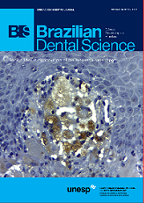Marginal leakage of temporary restoration after intraradicular post preparation with or without waterproofing
DOI:
https://doi.org/10.14295/bds.2017.v20i2.1411Abstract
Objective: This study evaluated the leakage volume of 1% Rhodamine B which received or not an internal waterproofing material. The hypothesis is that the waterproofing reduces microleakage. Material and Methods: Forty-two human teeth were selected for this study. After access, preparation, and filling of root canals, the teeth were divided into 3 groups: GI – sealed with Cimpat Blanc®, without intraradicular post/core preparation; GII - sealed with Cimpat Blanc®, with intraradicular post/core preparation, and GIII – sealed with Cimpat Blanc®, with intraradicular post/core preparation and internal waterproofing material with ethyl cyanoacrylate. T-test was used to analyze difference between initial and final weight and there was difference (p < 0.05). To analyze infiltration of the colorant, the volume was the comparison variable. Results: Shapiro Wilk- test was applied and showed normal distribution of the variables. ANOVA (p = 0.0013 / p<5%) applied and determined a statistical difference between the groups. When comparing the groups together, GIII show the smallest leakage rate when compared with the other groups, being statistically different (Tukey test - p < 0.5). Conclusion: In endodontically treated teeth receiving temporary restoration, the use of ethyl cyanoacrylate as internal waterproofing material is effective in preventing microleakage.
Keywords
Dental leakage; Endodontics; Dental restoration, temporary; Coloring agents.
Downloads
Downloads
Published
How to Cite
Issue
Section
License
Brazilian Dental Science uses the Creative Commons (CC-BY 4.0) license, thus preserving the integrity of articles in an open access environment. The journal allows the author to retain publishing rights without restrictions.
=================




























